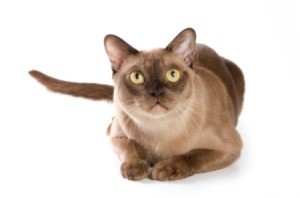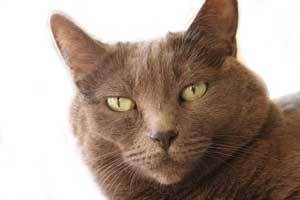
 Breed Description: The Burmese is a medium-sized cat with a straight back, deep chest and slender legs. They have small, rounded ears, a round-shaped head and rounded, slightly Oriental eyes. Their bodies are well-muscled and strong and their coats are very short and dense with virtually no undercoat. The characteristic that sets this breed apart is the distribution of color in their coats and their loving personalities.
Breed Description: The Burmese is a medium-sized cat with a straight back, deep chest and slender legs. They have small, rounded ears, a round-shaped head and rounded, slightly Oriental eyes. Their bodies are well-muscled and strong and their coats are very short and dense with virtually no undercoat. The characteristic that sets this breed apart is the distribution of color in their coats and their loving personalities.History & Origin: There are four prevailing theories behind the origin of the breed, all of them shrouded in mystery, and all involving how the 'founding female' of the modern day Burmese arrive in the U.S. One theory claims the cat was simply brought from India to the U.S. in the early 1930s. Another claims she was brought from Rangoon to the U.S in 1933 and originally sold as a 'Brown Siamese.' A third story says she arrived in New Orleans with a sailor who claimed to have acquired her in Burma, and who later sold her to a pet shop.
Character & Temperament: Burmese have an exceptionally sweet nature, are naturally inquisitive and thrive on human companionship. This breed will often follow its master from room to room as they do not like to be separated from their family. This breed is not suitable for a household without time to give it the attention it needs. This Burmese carries its playful kitten mentality into adulthood. They get along well with other cats and dogs and are very tolerant of children. Although social by nature, they have a quiet voice and radiate an inner calm.
Color: The distribution of color in the Burmese coat is striking, and comes in shades not found in other breeds. The colors fade into one another and are slightly darker on the head, legs and tail. The traditional color for this breed is brown (sable, but many colors and patterns have been added over time.)
Coat Type: Shorthair; The Burmese have a dense, very short coat with a fine, satiny texture.
Grooming: Little grooming is necessary other than an occasional brush and rub down-more when shedding. Claws should be trimmed and ears cleaned only when necessary.
Health Considerations: Prone to respiratory infections, heart defects, and ocular dermoids.
Trivia: Burmese are precocious, showing sexual interest as early as 5 months.